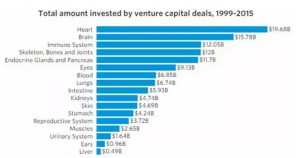Doctors treat the human body from a physiological point of view, painters mainly from an artistic point of view, while the venture capitalists may observe the human body from the perspective of investment. Every organ of the human body can inspire the development of new drugs, medical devices, as well as diagnostics.
Generally, most venture capitalists can consider the existing demand for treatment, research and development as well as the feasibility of a variety of factors before they actually make a choice. It’s reported that venture capitals have payed much money in a number of principal human organs. So, which parts of the human body are the most popular for venture capitalists?
Let’s first take a look at the total amount of money that venture capitalists spend on major organs of the body since these years.
Not surprisingly, both the heart and brain are vital for survival, but those organs that could be the positions for a variety of diseases also attract the maximum amount of investment. The immune system, bones, the endocrine glands have followed the rank. Surprisingly, the current investment fever, such as liver disease, does not seem to be the focus of investment.
1. Heart
Heart disease is one of the most common causes of death. And in terms of the entire medical device industry, heart series of instrument has once been the hottest areas. However, in recent years, some venture capitalists have dropped out of the field of medical devices, which leads to the decline of heart investment. In addition, partial venture capitalists who remain in the cardiovascular field also choose to exist the current mechanism.
2. Brain
With the recent advances in Alzheimer’s disease, Parkinson’s disease, the treatment of depression and other fields, modern medical research has achieved a breakthrough; venture capital institutions’ interest on brain diseases has increased sharply. They not only invest on drugs and medical devices, they also increase certain startups investment on the development of therapeutic software, computer games and other digital technologies.
3. Immune System
Abnormal immune system c an lead to a variety of diseases. In response, many start-up companies are competing to develop innovative therapies, among which the most dazzling is the cancer immunotherapy. In addition, some new treatments are constantly emerging, which can treat autoimmune diseases by regulating inflammation. These factors make the immune system attract investment fever in recent years.
an lead to a variety of diseases. In response, many start-up companies are competing to develop innovative therapies, among which the most dazzling is the cancer immunotherapy. In addition, some new treatments are constantly emerging, which can treat autoimmune diseases by regulating inflammation. These factors make the immune system attract investment fever in recent years.
4. Bones and Joints
After the investment boom of plastic surgery products in 2005-2007, venture capitalists’ interest in the field of orthopedics is generally declined.
5. Endocrine Glands
Diabetes is current protagonist in the field of medical care. A lot of investment comes into the field of type II diabetes, which accounts for about 95% of the total cases of diabetes. In addition, some companies are developing cell therapies to treat type I diabetes, which can make patients avoid from the insulin injections. A large number of companies have benefited from the share.
6. Eyes
Glaucoma, macular degeneration and other eye diseases in the years between 2013 and 2014 have absorbed large investment, but this boom has retreated in 2015, returned to the previous level. The details show that venture capitalists have come into a phase of rest to prepare for the next wave action. Another possible reason is that they no longer venture capital needs along with some ophthalmic drug companies successfully listed.
7. Blood
Investment in the field of blood diseases has increased in recent years, which might because venture capital firms have recently turned to the field of rare disease. Some rare diseases are also blood disorders, such as hemophilia and paroxysmal nocturnal hemoglobinuria, and so on.
8. Lung
Some areas of respiratory diseases, such as asthma and chronic obstructive pulmonary disease, have obtained a more stable cash flow from the venture. What is worth noticing is that the last few strokes of large investment flows to the field of cystic fibrosis, which is a hereditary lung disease.
9. Gut
Crohn’s disease and ulcerative colitis as well as other inflammatory bowel diseases could be a hot spot for investment enteropathy field. Currently, injecting drugs of Johnson/Abbvie might be the main treatment for such diseases. However, some venture capitalists are interested in turning the focus to those small companies that develop oral drugs.
ulcerative colitis as well as other inflammatory bowel diseases could be a hot spot for investment enteropathy field. Currently, injecting drugs of Johnson/Abbvie might be the main treatment for such diseases. However, some venture capitalists are interested in turning the focus to those small companies that develop oral drugs.
10. Kidney
Venture capitalist s are investing in those startups that develop disease treatments upon kidney stones, chronic kidney disease, acute kidney injury and renal cell cancer and other diseases. Renal cell carcinoma is the most common cancer of the kidney.
s are investing in those startups that develop disease treatments upon kidney stones, chronic kidney disease, acute kidney injury and renal cell cancer and other diseases. Renal cell carcinoma is the most common cancer of the kidney.
11. Skin
Start-up companies in this area mainly focus on diseases ranging from the most deadly cancer to the ailments such as melanoma. In addition, some companies that focus on beauty products also prefer to attract investment.
In fact, creative peptides are also the concern for modern life sciences research. The natriuretic peptides are a family of related hormones that play a crucial role in cardiovascular and renal homeostasis, such as l-methionine sulfone. Briefly, science is continuously attracting attention!